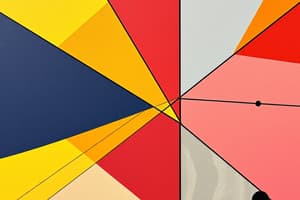Podcast
Questions and Answers
What is the property of an object where one side is the mirror image of the other side?
What is the property of an object where one side is the mirror image of the other side?
Symmetry
What type of symmetry occurs when a line of reflection can be drawn through the object, splitting it into two equal parts?
What type of symmetry occurs when a line of reflection can be drawn through the object, splitting it into two equal parts?
Line symmetry
Which shape is an example of a shape with point symmetry?
Which shape is an example of a shape with point symmetry?
Square
What type of symmetry occurs when an object can be rotated by a specific angle around a fixed point or axis and still appear identical to its original position?
What type of symmetry occurs when an object can be rotated by a specific angle around a fixed point or axis and still appear identical to its original position?
How many types of symmetry can an object possess?
How many types of symmetry can an object possess?
Flashcards are hidden until you start studying
Study Notes
Exploring Geometrical Ideas
Geometrical ideas form the foundation of our visual world, shaping our understanding of shapes, patterns, and space. In this article, we'll dive into some fundamental concepts including points, lines, angles, and symmetry, which serve as the building blocks for more advanced geometrical principles.
Points
At their most basic, geometrical ideas revolve around points. A point is a location in a plane or a three-dimensional space that has no dimension and no size. You can't draw or measure a point, but you can describe its location with coordinates or label it with a letter or number.
Lines
A line is a one-dimensional object that extends indefinitely in two directions. A line is formed by a sequence of points and can be classified as straight or curved. The length of a line segment is measured in units, and its endpoints are called the extremities.
Angles
An angle is formed where two lines intersect or where a single line is bent at a point. Angles are classified based on their size, measured in degrees or radians. A right angle (also known as a 90-degree angle) is when two lines intersect at a 90-degree angle. Acute angles are smaller than 90 degrees, and obtuse angles are between 90 and 180 degrees.
Shapes
Shapes are the two-dimensional figures that are made up of points, lines, and angles. They can be classified into two main categories: closed shapes (also known as polygons) and open shapes (also known as line segments). Common closed shapes include squares, triangles, circles, and hexagons. Open shapes include line segments, rays, and segments of circles.
Symmetry
Symmetry is the property of an object where one side is the mirror image of the other side. An object with symmetry can be cut into two equal parts along a line, and the two halves will be congruent. Symmetry can be classified into three types: line symmetry, point symmetry, and rotational symmetry.
Line symmetry occurs when a line of reflection can be drawn through the object, splitting it into two equal parts. A rectangle is an example of a shape with line symmetry.
Point symmetry occurs when a shape can be folded along a line or a point in such a way that the folded portion maps exactly onto its original position. A square is an example of a shape with point symmetry.
Rotational symmetry occurs when an object can be rotated by a specific angle around a fixed point or axis and still appear identical to its original position. A regular hexagon is an example of a shape with rotational symmetry.
Putting it Together
Understanding these fundamental geometrical ideas allows us to grasp more complex concepts and build upon our knowledge of shapes, patterns, and spatial relationships. For example, we can use our understanding of points, lines, angles, and symmetry to investigate properties of polygons, construct geometric proofs, or analyze the symmetries of crystals.
Geometrical ideas serve as a foundation for a variety of fields, from art to architecture to advanced mathematics, and exploring these concepts can be a fascinating and rewarding journey for those interested in the beauty and order of the world around us.
Studying That Suits You
Use AI to generate personalized quizzes and flashcards to suit your learning preferences.




